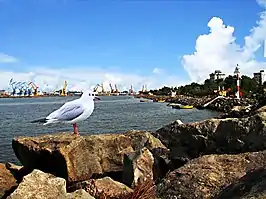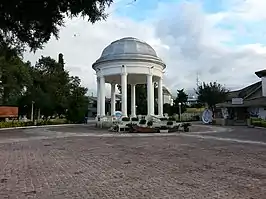Bandar-e Anzali
Bandar-e Anzali (Gilaki: اٚنزٚلي, Persian: بندرانزلی, renamed as Bandar-e Pahlavi during the Pahlavi dynasty)[3] is a city in the Central District of Bandar-e Anzali County, Gilan province, Iran, serving as both capital of the district and of the county.
Bandar-e Anzali
بندرانزلی | |
|---|---|
City | |
      | |
 Bandar-e Anzali | |
| Coordinates: 37°28′15″N 49°28′12″E[1] | |
| Country | |
| Province | Gilan |
| County | Bandar-e Anzali |
| District | Central District |
| Government | |
| • Mayor | Hossein Beikzadeh (acting) |
| Population (2016)[2] | |
| • Total | 118,564 |
| Time zone | UTC+3:30 (IRST) |
| Website | www |

At the 2006 National Census, its population was 109,687 in 32,424 households.[4] The following census in 2011 counted 116,664 people in 38,128 households.[5] The latest census in 2016 showed a population of 118,564 people in 41,053 households.[2]
Anzali is one of the most important cities in Iran in terms of tourism, economics, and athletics.[6][7][8] Bandar-e Anzali is the biggest Gilaki speaking city in the world after Rasht, the capital of Gilan province. The city was home to the first and biggest port on the southern shores of the Caspian Sea. Bandar-e Anzali consists of an island called Mianposhteh and the surrounding lands. Tourist attractions include a clock tower called Manareh, the long harbour promenade, and the water-logged delta and beach along the Sefid Rud.
History
Anzali is an old city in ancient Iran, first settled by the Cadusii. Owing to their pleasant relationship with Cyrus the Great, King of Anshan (Persia), and their military cooperation in Cyrus's founding of the Achaemenian Empire, the Cadusii adopted the name Anshan-e Pars (Ανσνάν in Greek), meaning "the Anshans of Persia".
This word in Middle Persian is Anzalag; a variant Persian form is Anzalazh. Anzali Gulf was a safe harbour for trade ships and fishing boats. It was renamed to Pahlavi in 1935.
In 1919, with the collapse of General Anton Denikin's White Russian army, eighteen of his ships sought refuge in Anzali. On 18 May 1920, a Soviet flotilla of thirteen ships launched a surprise attack on Anzali, capturing the British garrison and the eighteen White Russian ships. This allowed for the establishment of the short-lived Persian Socialist Republic and the Persian Communist Party. Soviet authorities denied responsibility for the attack, blaming the local Russian naval commander for attacking under his own authority.[9]
Its wonderful lagoon, Customs and City Hall edifice (Shahrdari), Mian Poshte Palace, and Motamedi Edifice are its tourist attractions. Anzali was the site of the Caspian University of Naval Science until 1980, when it was moved to Nowshahr. Naser-al-din Shah's[10] Shams-ol-Emareh tower[11] (not to be confused with the Tehran building of the same name) was built by Moayer al Mamalek. The famous Sangi Bath was destroyed by people and natural factors.
The Sangi Bath was noted for its marvelous durable system of basins with heated water. Some groups think that Motamedi Edifice had been changed; it is now its police office. This Ghajar Structure built in two floors with the help of Mirza Abd-ol-Vahab.[12]
Geography

The Anzali Lagoon divides the Anzali Port in two parts. The city is connected by two bridges to the Beheshti Island. There is a caviar processing factory in Bandar-e Anzali, some old ruins from 19th century and the popular Shanbeh Bazaar. Tourbebar is a village about 40 kilometers from Bandar-e Anzali, near the Anzali Lagoon.
Demographics
Historically Anzalis were mostly involved in the fish trade. Rice farming and agriculture are the other traditional jobs in Anzali, and are practiced in the villages surrounding the city.
The majority of Anzalis are adherents of Shia Islam, although there is a sizeable Armenian Christian minority.
The people of Anzali speak Gilaki as their mother language and Persian as the national language.[13] Specific Anzali Accent of Western Gilaki language is the main language of Anzali.[14][15][16][17] [18] [19]
Climate
Bandar-e Anzali has a humid subtropical climate (Cfa) under the Köppen climate classification and humid subtropical climate (Cf) under the Trewartha climate classification, with warm, humid summers and cool, damp winters. It has the most humid climate of any city in Iran, similar in its heavy autumn and early winter rainfall, persistent high humidity and low sunshine to the Sea of Japan coast of Japan, though it receives much less summer rainfall than that region. The warm and humid weather has allowed this region to grow crops such as rice and tea that require very large amounts of moisture, especially with the extra water draining from the Elburz Mountains.
| Climate data for Bandar-e Anzali | |||||||||||||
|---|---|---|---|---|---|---|---|---|---|---|---|---|---|
| Month | Jan | Feb | Mar | Apr | May | Jun | Jul | Aug | Sep | Oct | Nov | Dec | Year |
| Record high °C (°F) | 29 (84) |
31 (88) |
33 (91) |
36 (97) |
36 (97) |
35 (95) |
37 (99) |
36 (97) |
33 (91) |
37 (99) |
34 (93) |
31 (88) |
37 (99) |
| Average high °C (°F) | 10.1 (50.2) |
9.7 (49.5) |
11.4 (52.5) |
16.1 (61.0) |
21.7 (71.1) |
26.7 (80.1) |
29.4 (84.9) |
29.2 (84.6) |
25.8 (78.4) |
21.3 (70.3) |
16.5 (61.7) |
12.6 (54.7) |
19.2 (66.6) |
| Daily mean °C (°F) | 7.3 (45.1) |
7.1 (44.8) |
8.9 (48.0) |
13.5 (56.3) |
18.8 (65.8) |
23.4 (74.1) |
26.0 (78.8) |
25.8 (78.4) |
22.6 (72.7) |
18.3 (64.9) |
13.6 (56.5) |
9.7 (49.5) |
16.3 (61.2) |
| Average low °C (°F) | 4.5 (40.1) |
4.5 (40.1) |
6.5 (43.7) |
10.8 (51.4) |
15.9 (60.6) |
20.2 (68.4) |
22.5 (72.5) |
22.3 (72.1) |
19.5 (67.1) |
15.3 (59.5) |
10.6 (51.1) |
6.8 (44.2) |
13.3 (55.9) |
| Record low °C (°F) | −7 (19) |
−4 (25) |
−4 (25) |
−1 (30) |
6 (43) |
10 (50) |
15 (59) |
16 (61) |
11 (52) |
6.6 (43.9) |
0 (32) |
−4 (25) |
−7 (19) |
| Average precipitation mm (inches) | 167.8 (6.61) |
120.2 (4.73) |
110.7 (4.36) |
60.2 (2.37) |
46.7 (1.84) |
52.0 (2.05) |
46.0 (1.81) |
111.9 (4.41) |
271.5 (10.69) |
326.0 (12.83) |
300.2 (11.82) |
217.3 (8.56) |
1,830.5 (72.08) |
| Average precipitation days | 14.3 | 13.1 | 15.1 | 12.8 | 11.6 | 7.2 | 6.3 | 9.3 | 13.5 | 15.4 | 14.6 | 14.1 | 147.3 |
| Average relative humidity (%) | 86 | 86 | 88 | 86 | 83 | 79 | 76 | 79 | 85 | 87 | 87 | 86 | 84 |
| Mean monthly sunshine hours | 91.3 | 88.3 | 96.7 | 134.5 | 200.8 | 248.5 | 257.4 | 217.4 | 161.6 | 124.0 | 101.1 | 90.8 | 1,812.4 |
| Source: Synoptic Stations Statistics | |||||||||||||
Caviar
Bandar-e Anzali is a center of caviar production. The preparation and marketing of which is a state monopoly, handled through the Iranian Fishing Company under the control of the Finance Ministry. The public is not admitted to the immense refrigerated hangars where tons of sturgeons, some as large as 3 meters long and weighing 100 kilograms, are stored after the removal of the caviar, usually equivalent to about one tenth of their weight.
Sports
The most popular sport in Anzali is football, and the city is known as a football hub in Iran. Malavan, one of the most famous teams in Iran, is the main team of the city, and they currently play in the second tier Azadegan League. Current and former national team players such as Sirous Ghayeghran, Saeid Ezatolahi, Mohammad Mayeli Kohan, Jalal Hosseini, Maziar Zare, Mohammad Gholami, Jalal Rafkhaei, and Sosha Makani are from Anzali.
Gallery

 Bandar-e Anzali Blvd.
Bandar-e Anzali Blvd. A walkway in Anzali
A walkway in Anzali City Hall Of Bandar-e Anzali
City Hall Of Bandar-e Anzali Destructed pavilion of Anzali
Destructed pavilion of Anzali Russian ships docking in Bandar-e Anzali harbour
Russian ships docking in Bandar-e Anzali harbour The harbour of Bandar-e Anzali
The harbour of Bandar-e Anzali Coast of Bandar-e Anzali
Coast of Bandar-e Anzali
 Colorful houses in Anzali
Colorful houses in Anzali The first newspaper agency in Anzali
The first newspaper agency in Anzali GhalamGoodeh Bridge in Anzali
GhalamGoodeh Bridge in Anzali Anzali port docks
Anzali port docks
References
- OpenStreetMap contributors (2 October 2023). "Bandar-e Anzali, Bandar-e Anzali County" (Map). OpenStreetMap. Retrieved 2 October 2023.
- "Census of the Islamic Republic of Iran, 1395 (2016)". AMAR (in Persian). The Statistical Center of Iran. p. 01. Archived from the original (Excel) on 4 December 2020. Retrieved 19 December 2022.
- Bandar-e Anzali can be found at GEOnet Names Server, at this link, by opening the Advanced Search box, entering "-3055109" in the "Unique Feature Id" form, and clicking on "Search Database".
- "Census of the Islamic Republic of Iran, 1385 (2006)". AMAR (in Persian). The Statistical Center of Iran. p. 01. Archived from the original (Excel) on 20 September 2011. Retrieved 25 September 2022.
- "Census of the Islamic Republic of Iran, 1390 (2011)" (Excel). Iran Data Portal (in Persian). The Statistical Center of Iran. p. 01. Retrieved 19 December 2022.
- http://ilna.ir/news/news?id=9047%5B%5D
- "10ميلياردريال اعتبار به توسعه زيرساختهاي اقتصادي گيلان اختصاص يافت". Archived from the original on 2013-10-23. Retrieved 2018-10-20.
- "Archived copy". Archived from the original on 2012-09-03. Retrieved 2018-10-20.
{{cite web}}: CS1 maint: archived copy as title (link) - A Peace to End All Peace, David Fromkin, 1989, pp.458-459.
- Bakhtiar, Kaveh (2004). "Palatial Towers of Nasir al-Din Shah". Muqarnas. 21: 33–43. doi:10.1163/22118993-90000052. JSTOR 1523342. Retrieved 2022-05-04.
- "Bandar-e-Anzali-Shamsol-Emareh". Retrieved 2022-05-04.
- "انزلی کلاب". Retrieved 8 October 2015.
- Bazin, Marcel (1986). "ANZALĪ". Encyclopaedia Iranica, Vol. II, Fasc. 2. pp. 143–145.
- Jahangiri, Dr. Nader. گویش گیلکی لاهیجان [Lahijani Dialect of Gilaki] (in Persian). Iran: Tokyo University of Foreign Studies.
- Resaei, Ayoub (2006). "گویش گیلکی فومنات" [Foumani Dialect of Gilaki] (in Persian). Iran: Allameh Tabataba'i University: 65.
{{cite journal}}: Cite journal requires|journal=(help) - Sotoudeh, Manouchehr (1953). فرهنگ گیلکی [Gilaki Culture] (in Persian and Gilaki). Iran: فرهنگ ایلیا. pp. 17, 18.
- Shokri, Giti (2006). گویش رامسری [Ramsari Dialect] (in Persian). Iran: پژوهشگاه علوم انسانی و مطالعات فرهنگی. p. 14.
- "Glottolog 4.7 - Western Gilaki".
- "Gilaki | Ethnologue Free".
- "Language distribution: Gilan Province". Iran Atlas. 2015. Retrieved 22 March 2021.
External links
- Official website
- www.anzaliport.ir Archived 2007-07-17 at the Wayback Machine
- Anzali News
